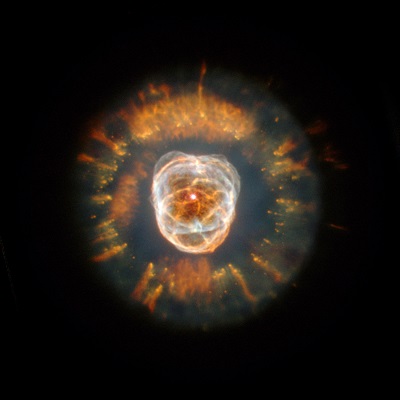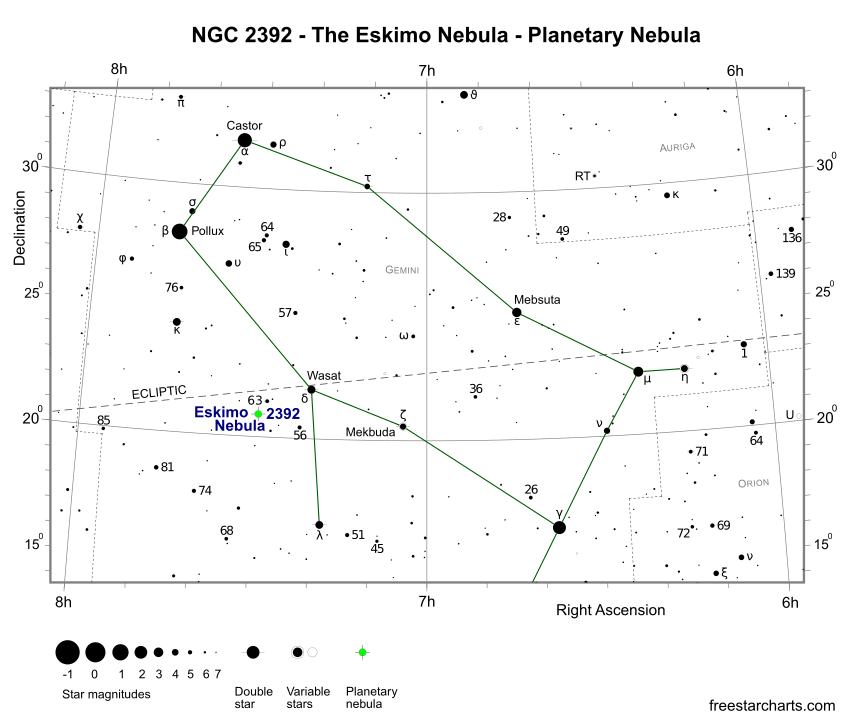NGC 2392 is a 9th magnitude bipolar double shell planetary nebula located in the constellation of Gemini. Resembling a person's head surrounded by a parka hood, it's commonly known as the "Eskimo Nebula" or "Clown Face Nebula". William Herschel discovered this planetary nebula from his observatory in Slough on January 17, 1787, describing it as a 9th magnitude star with a bright centre surrounded by equally dispersed nebulosity.
Locating the Eskimo Nebula is relatively easy since it's positioned just east of constellation centre and close to Wasat (δ Gem - mag. +3.5). The easiest way to find Gemini is by identifying its two brightest stars Castor (α Gem - mag. +1.58) and Pollux (β Gem - mag. +1.16). They are positioned east of the Hyades open cluster in Taurus and northeast of the bright prominent constellation of Orion.
Imagine a line extending from Pollux - the brighter of the twins - in a southwesterly direction towards Orion's belt. Positioned just over 8 degrees along this line is Wasat and 2.3 degrees southeast of Wasat is NGC 2392. The planetary nebula is positioned next to a mag. +8.2 yellow-white star. Through a telescope the pair appears as a wide double star, separated by about 100 arc seconds.


Finder Chart for NGC 2392 - pdf format (credit:- freestarcharts)
At 9th magnitude, the Eskimo nebula is a challenging binocular object. It can be detected in 10x50 binoculars, although faint and stellar like in appearance. However, it may be possible to notice a twinkling effect when switching between normal and averted vision suggesting at its true nature. With small scopes of the order of 80mm to 100mm (3.1 to 4 inches) aperture, its diminutive size of 48 arc seconds can present problems to observers hunting with low powers. With an apparent size no larger than Jupiter at opposition, it appears as a tiny out of focus star with a noticeable bluish-green tint. Once located, switch to higher powers to reveal the 10th magnitude central star and fuzzy encircling disk.
Since it's a compact object with a high surface brightness, NGC 2392 takes magnification well. When viewed through a medium size 200mm (8-inch) scope at medium to high magnifications intrigue details in the nebulosity can be seen, including dark arcs imposed on a mottled background. An Ultra High Contrast (UHC) filter may also help to bring out finer details. The planetary appears intense bluish-green in colour. As is common with objects of this type, it appears to often blink on and off.
In January 2000, the Hubble Space Telescope (HST) captured a majestic image of NGC 2392. Visible in superb detail were the glowing remains of this dying star, exposing striking filaments of gas and matter extending outwards from an intriguing bubble of inner twinning material. Larger size amateur telescopes of the order of 300mm (12-inch) or greater provide a glimpse of the spectacular detail present in the Hubble image.
The distance to NGC 2392 is not accurately known but is estimated to be about 2,900 light-years, corresponding to a spatial diameter of 0.68 light-years.
NGC 2392 Data Table
| NGC | 2392 |
|---|---|
| Caldwell | 39 |
| Name | Eskimo Nebula |
| Object Type | Planetary Nebula |
| Constellation | Gemini |
| Distance (light-years) | 2,900 |
| Apparent Mag. | +9.1 |
| RA (J2000) | 07h 29m 11s |
| DEC (J2000) | +20d 54m 42s |
| Apparent Size (arc mins) | 0.8 |
| Radius (light-years) | 0.34 |
| Other Name | Clown face Nebula |